Urbanity Day One: Five Key Takeaways

More than 600 property sector players have taken part in day one of The Urban Developer’s flagship conference, Urbanity, on the Gold Coast.
Across keynotes, panel discussions, workshops and more, the conference is tackling Australia’s most pressing development challenges.
Here’s five key takeaways from the day:
Housing crisis demands radical solutions
With Australia needing to deliver 600 houses a day just to keep up with population growth and immigration, speakers said we should be treating housing as critical infrastructure and embracing innovative approaches from 3D printing to modular construction.
Technology as “foundation, not feature”
We can fight it no longer: AI and automation emerged have been deemed essential tools for revolutionising construction productivity, with applications ranging from quality control to supply chain management and development assessment.
The need for nature integration
While the property development industry is uniquely positioned to address systemic housing challenges, it also needs to turn its attention to addressing the climet crisis. Urban areas generate 75 per cent of global emissions and require fundamental redesign with green infrastructure, biodiversity, and circular economy principles at their core.
We’re on the cusp of the next supercycle
Despite challenges, property leaders identified generational buying opportunities driven by population growth, falling interest rates, and an "80-year migration super cycle".
Collaboration, not competition
From government-private partnerships to cross-industry innovation, speakers emphasized that Australia's urban challenges can only be solved through coordinated action and shared responsibility.
Read on a for a comprehensive wrap of the day.
Do it because of the love of the project
2.45pm: Soheil Abedian has been developing properties since the days of “the white shoe brigade”.
He is the man behind what The Urban Developer chief executive said is “Queensland’s most recognisable building”—the Q1 on the Gold Coast .
Abedian (pictured below with The Urban Developer chief executive Adam Di Marco) delivered projects for Versace and some of the world’s wealthiest, but it’s the Clem Jones Sunland Leukaemia Foundation Village at Coopers Plains in Brisbane building and the Abedian School of Architecture in Robina “are the two buildings I’m most proud of”.

His ASX-listed Sunland business wrapped up in 2023 and, after very briefly pondering retirement, he now runs Abedian and Co with is son and loves not having to answer to shareholders.
“You do it because of the love of the project, the love of creating. We dance with our own music.”
Abedian, whose company now pays him a ‘modest’ wage and donates the rest to more that 100 charitable foundations, doesn’t believe we have a housing crisis.
“We have a crisis of ethics. We have crisis of morality, generosity and love for our country.
“I am part of the one per cent in the world who controls most of the world’s wealth. I am on record saying please tax me more. Enough is enough. It is time to give, not time to accumulate.
“What is left behind is the good name, and that is what the developer needs to do.”
The bottom line
“Our world is a very challenging world,” he says, but urges developers to push on.
“When development is good, it’s really, really good. But when it’s bad, it’s really bad.
“My advice is ‘do it’ because you want to leave legacy behind, not just because it’s feasible. Money comes with that. But if your objective is only to make money, you will lose.”
More to come
Archipelago’s ‘smarter’ masterplan for a BOLD Brisbane
2.30pm: The City of Brisbane has an ambitious strategy for urban transformation, designed by Archipelago and centred on the 2032 Olympic Games.

Designed from the outset to be a piece of knowledge infrastructure, Archipelago founding director Peter Edwards (pictured) wants to turn this knowledge precinct into a knowledge corridor, developing world-class infrastructure, and reimagining urban growth through strategic government-owned land development.
His plan emphasises connectivity, sports facilities, and a knowledge-driven economic approach that could reshape the city’s future.
“We need to give ourselves permission to build the city of our dreams,” Edwards said, “because the alternative dooms us to forever board airplanes and suffer the long journey to visit those cities on the other side of the world.”
Reimagining Brisbane’s future
“This is not just about planning for games,” Edwards said.
“It’s about reimagining Brisbane’s future through open space, movement and meaningful city making that will serve generations to come.”
“We’re not just building arenas, we’re not just building national aquatic centres. We’re not just building stadiums, we’re building knowledge infrastructure.”
The bottom line
“This moment for this once-ever event approaching us in 2033 has the power to reshape the entire city, and it’s entirely in our control.”
Built to be disassembled
2.15pm: Tzannes principal Amy Dowse is one of Australia’s pioneering architects championing the use of mass engineered timber and buildings built to be disassembled.
“Timber looks, feels and smells warm, and can have really positive effects on workplaces. We find they’re a healthier, happier environment,” Dowse said.

Lendlease’s International House and Daramu House, designed by Tzannes, were Australia’s first fully engineered timber buildings.
They achieved a 50 per cent carbon reduction compared to conventional concrete construction. One was assembled by just seven people with zero injuries. One of them even came in $12 million under budget and delivered an extra floor of yield.
“Everything is bolted together, it’s dry construction, quick to go up and even quicker to go down,” Dowse said.
“The file-to-factory approach is designed as a kit of parts that can be disassembled at a later date. The timber, structure and facade can all be unbolted.
“It takes a little more time and effort in the design stage, but the construction stage is so fast and clean and well worth the wait.”
The lightweight mass timber approach reduced environmental impact, construction time, and costs while maximising development potential on challenging urban sites.
Lendlease was so happy with the results of the first building, that it’s has promptly lined up for another timber project, due to significantly high tenant demand.
The bottom line
“We need to design for the longevity and be conscious of our decisions for the future. If we can adapt and reuse, assemble, disassemble, and I feel like we have a whole lot more ways to be more sustainable and future.”
Construction hasn’t evolved in centuries...until now
2pm: Using high-performance concrete mixtures similar to that used in skyscrapers, Contour3D aims to drag the construction industry kicking and screaming into the future.
Contour3D founder Nick Holden, who’s team designed built and put into play Australia’s first active 3D house printer, said the construction industry is the last major sector to adopt automation.

“When I say construction hasn’t evolved in centuries until now, I do get a little pushback,” he said.
But his vision for the sector is bold and becoming more necessary each day.
“There’s been a 22 per cent drop in apprenticeships in the year end 2023,” he said. “Construction labour, skilled labour, is declining and we need to build 600 houses a day just to keep up with population growth and immigration.”
The two Aboriginal social housing duplexes in regional New South Wales Contour3D built were not built, but ‘printed’ in 15 days, with keys handed over to the client—in this case the NSW government—in 16 weeks.
And it’s not just producing cookie cutter homes, although that’s well within its remit.
Walls that look like forest contours, concrete twists, turns and curves—the design possibilities are endless.
“As long as we can code it and put it in the computer, we can put your logo, even your face in it. The printer doesn’t care.”
Contour3D can set up on site, as a factory in a field, print directly or create prefab walls that can be printed and transported within 24 hours.
And there’s a mobile printer coming soon.
His work with Mirvac will soon deliver Australia’s first commercial 3D printed building.
Different applications in urban settings include park furniture chairs picnic tables, road columns, bridge spans walkways, skate parks.
The bottom line
Holden said it’s unrealistic to say his printers will end the housing shortage, but believes with scale, support and government assistance “at least, we could be a practical solution to add into that many factors”.
More to come
Earlier...
9.00: Welcome to the first day of Urbanity on the sunny Gold Coast, where big ideas meet inspiring stories and incredible projects.
Join The Urban Developer team and 600-plus delegates for live updates on all the news coming from the main stage at The Star on the Gold Coast.
Coming up today:

The Urban Developer’s seventh annual flagship summit—Urbanity 25—opened this morning with a Welcome to Country ceremony, setting the stage for The Urban Developer chief executive Adam Di Marco to address the industry’s most pressing challenge: Australia’s housing crisis, which he says has reached “breaking point”.
“Housing is a human right, it’s completely unfathomable that half a million people sleep rough every night,” Di Marco said.
He said the property development industry is uniquely positioned to address these systemic housing challenges.
Di Marco said innovation remained essential for meeting community demands, particularly in Australia’s fastest-growing urban centres including the Gold Coast, Brisbane, Sydney, and Melbourne.
Collaborative approaches—bringing together industry professionals to forge solutions—represent the most effective path forward, he told the conference.
Di Marco also championed the industry’s social responsibility, noting that supporting organisations like the Property Industry Foundation creates measurable impact in combating youth homelessness.
He called on developers to prioritise outcomes that genuinely serve community needs across housing and broader urban development projects.
He said the aim of Urbanity is to spark innovative approaches and create meaningful transformation within the property sector to address these most pressing challenges.
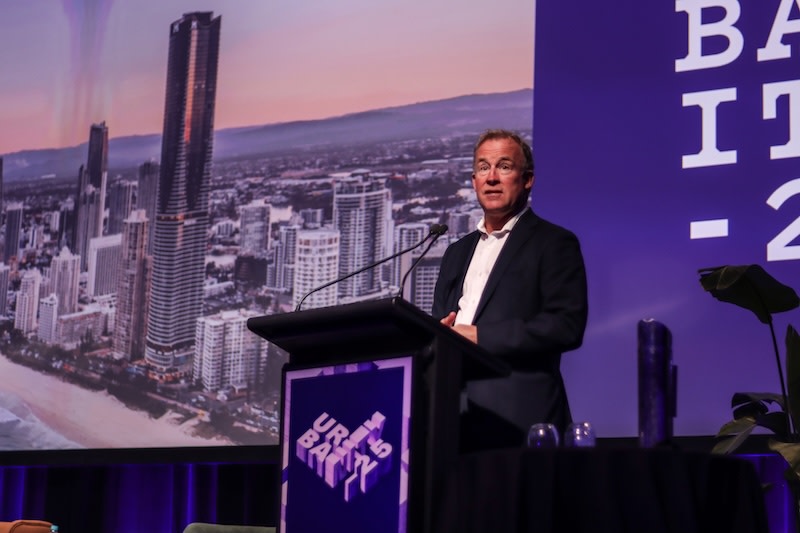
More to the Gold Coast than tourism
Invest Gold Coast chair Will Hodgman (pictured) has highlighted the city’s economic diversification beyond tourism into health, education, tech, and advanced manufacturing.
The Gold Coast was attracting younger demographics and has had a 20 per cent capital growth increase this year but faces challenges over affordable housing and infrastructure demands due to rapid growth, he said.
On economic evolution
“There’s so much more. It’s a lot deeper story than that and invest Gold Coast has determined that there are many additions to a diversified and rapidly growing economy.”
On growth pressures
“There’s a massive infrastructure demand on this city as well, which presents challenges in the form of affordable and sustainable housing.”
“We need to ensure that it’s more accessible and easier to get around, and there’s also capacity for the city to grow beyond the coastline.”
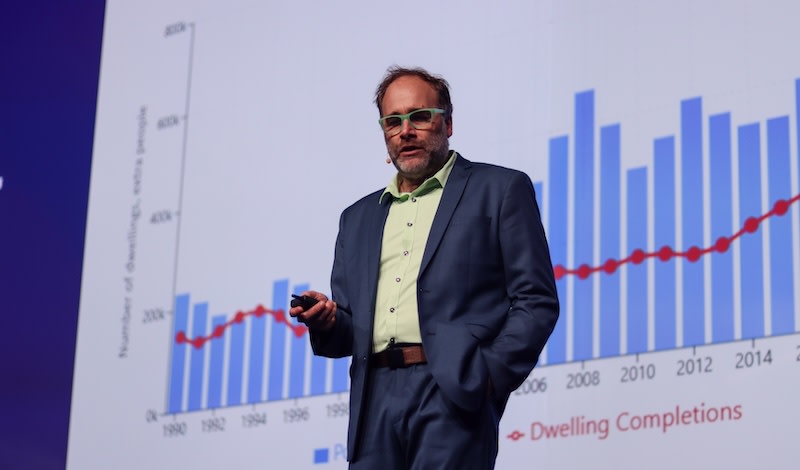
AI, innovation key to solving construction woes
9.15: CSIRO chief research consultant Stefan Hajkowicz (pictured) said innovation and AI adoption was the “big lever” needed to address the country’s severe housing crisis.
Australia is building dramatically fewer homes relative to population growth, Hajkowicz said.
“In an average year since 1990 for every 1000 new people, we built 636 dwellings. In 2023 we only built 276 dwellings for those 1000 people, in 2024 it was 367 dwellings, which puts us at almost half of the normal output,” he said.
Industry challenges
In 2023, 217 construction firms became insolvent, up from 250 the previous year and 67 technician and trade occupations are experiencing a persistent shortage.
The industry estimates it needs 90,000 more tradies by 2029.
Construction productivity has actually declined, Hajkowiczs said as “it takes more people, more hours, more person hours to build a house today than it did 30 years ago”.
The AI Solution
While acknowledging “there’s no simple AI button that you’re going to push to fix the woes of the construction sector”, Hajkowicz said AI could revolutionise areas like development assessment, supply chain management, and quality control.
He said 30 per cent of construction work was currently rework, suggesting significant efficiency gains possible through AI-powered quality control and design optimisation.
“There might be some augmentation of tradies, but it’s not like AI and robotics are a total solution,” he said.
“It’s complex. Translating it into productivity and meaningful application is really hard.”
Bottom line
The construction sector’s low investment in R&D and innovation must change to solve Australia’s housing crisis, with AI playing a crucial but complex role in the solution.
“We’ve got to fix the productivity issue, and we’ve got to turn to innovation, doing things smarter, more with less, better use of materials,” he said.
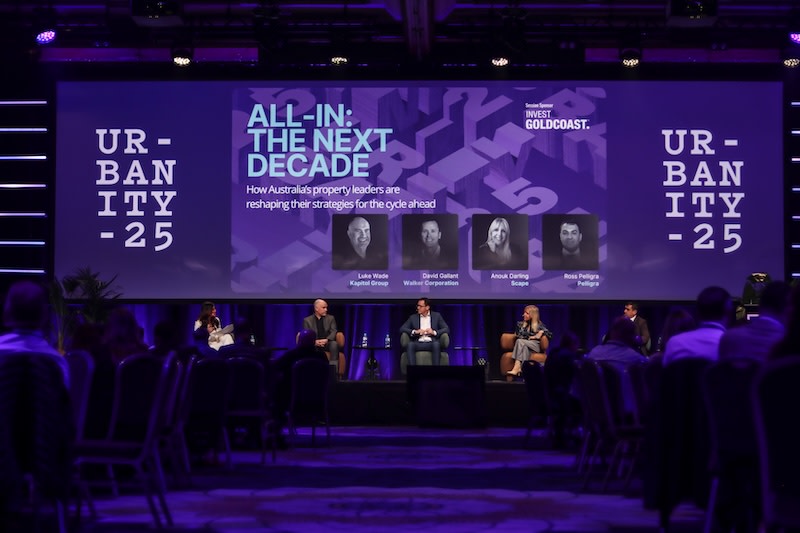
Crisis as opportunity
9.45: Kapitol operations manager Luke Wade, Walker Corporation chief executive David Gallant, Scape chief executive Anouk Darling and Pelligra founder Ross Peligra talked about how Australian property leaders are transforming sector challenges into innovation catalysts.
Gallants said that “challenges we have as an industry are actually opportunities”.
Despite housing crises and regulatory hurdles, the group remains optimistic about growth through technology and community-focused development.
“International students are actually Australia’s largest service export”
Scape chief executive Anouk Darling said international students have been unfairly blamed for Australia’s housing crisis.
“…because of all the headlines, Australians are caught up in the misconception that international students are taking away from Australians,” Darling says.
“International students are actually Australia’s largest service export... they only take to 6 per cent of residential rent” and “they’re certainly not” adding to the housing crisis nor taking away from Australians but “actually contributing”.
“Technology is no longer a feature, it’s becoming a foundation”
The sector is embracing digital transformation with companies implementing AI for such tasks as multi-language communication and 3D modelling for project assessment.
Companies are obsessively reducing waste. “We made a conscious decision two years ago, we would measure our waste” throughout their business processes, Gallant said.
Challenges x solutions
Significant housing shortage affecting both students and general population.
“But PBSA is actually a solution to alleviating the residential issues,” Darling said.
Despite regulatory challenges, there’s significant pipeline development with 19,000 beds acquired and 5000 apartments coming online in the next 18-24 months.
Planning delays, punitive tenancy acts, and government policies that don’t understand purpose-built student accommodation are also hampering the industry.
The group would like to see more industry advocacy and collaboration with government.
The panel emphasised technology as foundational rather than optional, with implementations including AI for multi-language communication, 3D modelling for feasibility assessment, digital workforce development and waste reduction through design and modelling.
“Technology, I think, is no longer a feature. It’s becoming a foundation, and everyone expects it—from our investors to how we deliver experiences,” Wade said.
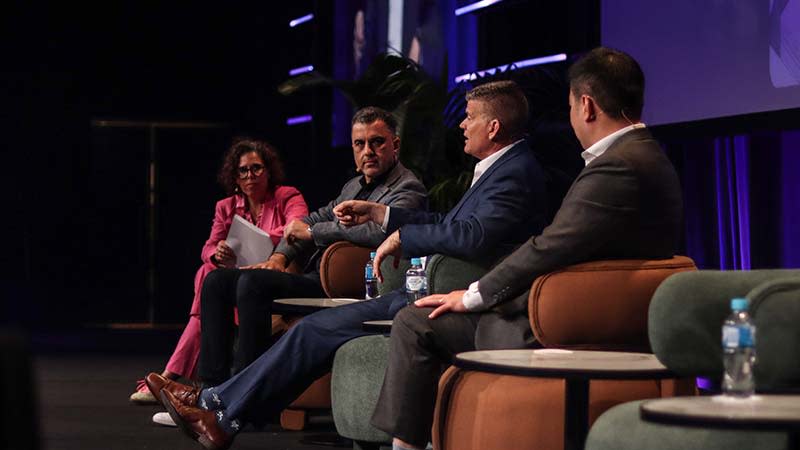
On the cusp of a super, super cycle
11.00: The Australian real estate market is experiencing the early stages of a super cycle, with key opportunities for strategic investments across residential, commercial, and mixed-use developments.
Peregrine Projects managing director Joseph Chahin, KordaMentha partner Tony Massaro and MaxCap Group head of research Bruce Wan believe there are plenty of unique buying opportunities driven by population growth, falling interest rates, and demographic shifts.
Australia “a market of micro markets”
“They’re all very different and you need to understand the markets to play in them,” Massaro said.
Melbourne in particular has experienced significant equity depletion over recent years, creating buying opportunities with land rates not seen for extended periods.
Population growth continues driving demand, with Australia experiencing what Wan called an “80-year migration super cycle” adding numbers “about the size of a Gold Coast population” annually.
Massaro is particularly keen on senior living developments, with baby boomers entering what he said was a 14-year super cycle of turning 75.
Interest rate cuts are providing immediate relief, with each 20-25 basis point reduction generating approximately 5-2.5% improvements in asset valuations, Wan said.
Slumped sectors show signs of life
Commercial sectors including office, retail, and industrial are showing signs of recovery after reaching bottom, while demographics are creating sustained demand in senior living developments.
Key challenges include managing construction costs, adapting to post-Covid working arrangements, and navigating complex capital markets.
The office sector faces ongoing uncertainty with hybrid working models, though institutional capital is beginning to re-examine opportunities.
Massaro said Covid has changed the way we work, and “that genie is not going back in the bottle” quoting about 70 per cent currently working from home right now “but we’re starting to see more of them coming back into the office, especially young people”.
“So I think there will be success stories in offices, and while most money going into office right now is private money, institutional capital is also starting to look at the office space.”
The bottom line
The real estate market is entering a potentially transformative period with opportunities across residential, commercial, and specialised sectors.
“If you choose your lane, understand your value proposition and go forth, mitigate the risks, you can do great things,” Massaro said.
Strategic investors who understand local micro-markets and maintain discipline could capitalise on generational buying opportunities.
“Don’t sleep on the market cycle; it’s heading in the right direction,” Wan said.
Chahin is even more optimistic.
“We are on the cusp of a super, super cycle I haven’t seen, certainly since GFC,” Chahin said.
More to come
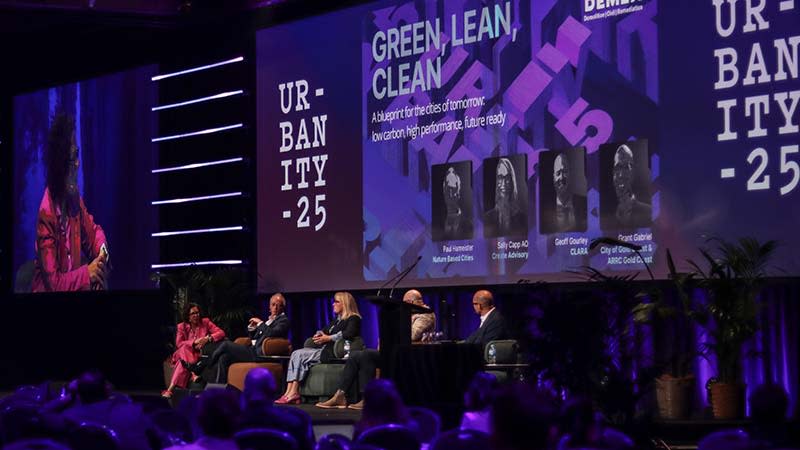
Nature-Based Cities: Reimagining Urban Spaces for Sustainability
11.30am: Urban development experts Paul Hameister, founder of Nature Based Cities, Create Advisory chief executive Sally Capp AO, CLARA director of ESG and program delivery Geoff Gourley and City of Gold Coast & Advanced Resource Recovery Centre Gold Coast program director Grant Gabriel gathered to discuss transforming cities into more sustainable, nature-integrated environments.
The conversation highlighted the critical need to redesign urban spaces with green infrastructure, biodiversity, and environmental performance at their core.
“We are at a crossroads,” Hameister said, adding that now is the time to choose between future sterile concrete landscapes or green, living urban environments.
Key discussions centred on incorporating green spaces vertically and horizontally, reducing carbon emissions, and creating more liveable cities.
Time to rethink
Capp said that urban areas contribute approximately 75 per cent of global emissions, warranting a rethink of not only new development, but also existing buildings as a focus for transformation.
Gourley said innovative approaches, including developing communities with 40 per cent green space and infrastructure hidden underground, while Grant from the Gold Coast discussed circular economy initiatives and waste management strategies.
Gourley said CLARA’s vision includes car-free communities with “40 green space” and hidden underground infrastructure, creating environments and 10-minute cities where “everything is walkable with great mobility”.
Grant Gabriel said Gold Coast’s “$1.5 billion investment” in “all the unsexy things” are “what makes the city work”. This includes seven new circular economy facilities addressing landfill emissions.
The bottom line
Successful urban transformation requires holistic thinking, policy support, and a fundamental reimagining of cities as living, breathing ecosystems that prioritise human and environmental wellbeing.
Collaboration is key.
“Projects like Greenline, for example, the 4km along the north bank of Melbourne’s Yarra River, can only be delivered by working hand in hand with private developers,” Capp said.
Hameister wants to see a fundamental shift in how we perceive urban development.
“Everything’s connected. We need to remember that we are vibrational energy connected to everything. We need to stop treating nature like a resource to exploit.”
More to come
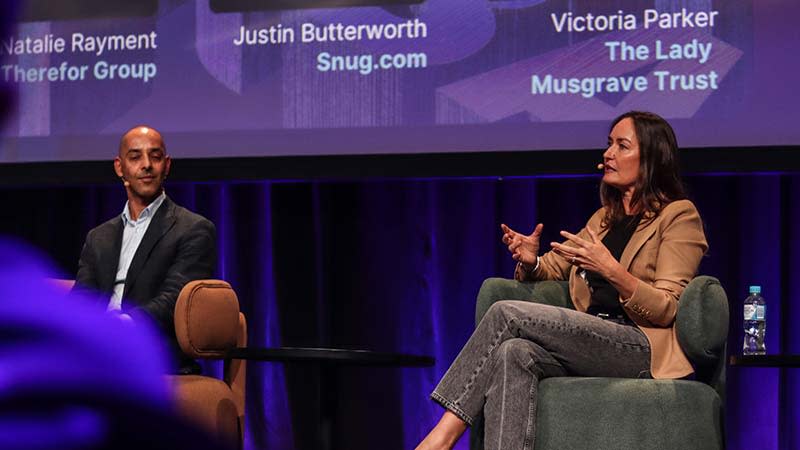
Innovation key to unlocking affordable solutions
12pm: Australia faces a critical housing crisis that demands innovative, collaborative approaches to increase affordable housing supply and accessibility.
A panel of development experts explored multifaceted strategies to address these challenges, focusing on diversifying housing typologies, creating flexible planning regulations, and developing partnerships between private developers, government, and community organisations.
Lady Musgrave Trust chief executive Victoria Parker believes housing homelessness is “actually solvable” but only with “coordinated action”.
Over its 140-year history The Lady Musgrave Trust has myriad successful partnerships, with Victoria adding that developers have also found social housing projects “profitable and commercially wise decisions”.
Therefor Group executive director Natalie Rayment also wants to see more “collective engagement” to address housing challenges.
Work needs to be done
Australia needs over 600 dwellings per 1000 people but is building only half that number.
Smaller, well-designed housing units, particularly for vulnerable populations like women and children experiencing domestic violence are what is needed most.
Coposit co-founder Chris Ferris outlined how platforms can help first-time buyers enter the market at an average age of 27, compared to the national average.
Snug.com founder Justin Butterworth wants to see a stop to penalising bold, innovative approaches and called for policy reforms that encourage creative housing solutions.
The bottom line
Solving Australia’s housing crisis requires treating housing as critical infrastructure with government incentives, modular construction, and leveraging faith-based land and “some bold politics that go with it”.
More to come















